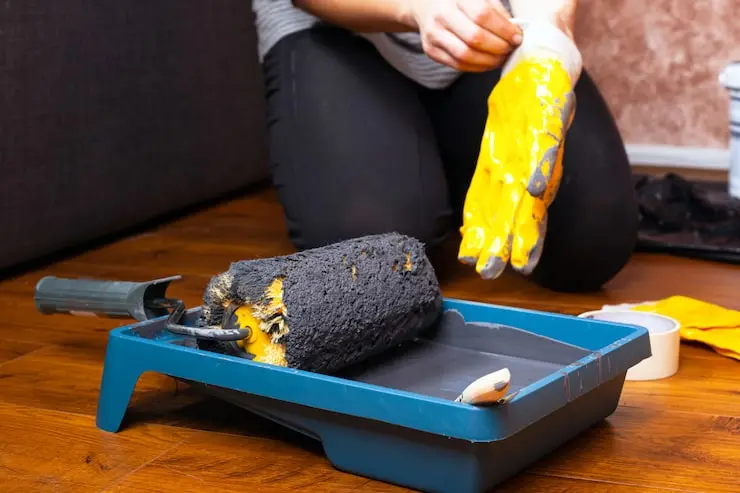When water unexpectedly pools on your kitchen floor, the problem is stressful and urgent. A leak coming from the base of your appliance, your dishwasher leaking from underneath, signals a break in one of the critical internal water or pump systems. This type of leak often causes serious damage to your subfloor damage and cabinets, so quick diagnosis is key.
Our goal here is simple: to help you understand precisely why is my dishwasher leaking from underneath, identify the source safely, and learn how to implement a fix now.
Table of Contents
How Do You Find a Leak in Your Dishwasher?

Before you start any repair work, you need to locate where the water is coming from. This saves time and prevents you from replacing parts that aren’t broken.
- Safety comes first. Turn off power at your breaker box before touching your dishwasher. Never work on any appliance while it’s plugged in. Next, shut off the water supply valve under your sink. This valve controls water flow to your dishwasher. Turn it clockwise until it stops.
- The paper towel test works best. Place dry paper towels on the floor around your dishwasher. Run a short wash cycle and check the towels every few minutes. Water appears first on towels closest to the leak. This tells you if water leaks from the front, back, or sides.
- Check when the leak happens. Does water appear right when the cycle starts? That points to your water supply line or inlet valve. Does it leak during the wash cycle? Look at your door gasket or water pump. Leaking during drainage means check your drain hose first.
Pull out your lower dish rack. Look inside the dishwasher tub for any standing water. Remove the filter at the bottom and inspect it. Food buildup here causes many leaks. While the filter is out, shine a light into the drain opening. Look for anything blocking water flow.
If you can access the space under your dishwasher, remove the kick panel at the bottom front. This metal or plastic panel hides the mechanical parts. Use a flashlight to inspect while someone runs a short cycle. Watch for drips, sprays, or water trails. This shows exactly which part is failing.
Why Is Your Dishwasher Leaking? 7 Common Causes from the Bottom
1. Damaged Door Gasket (Door Seal)
Your door gasket creates a watertight seal around the dishwasher door opening. This rubber strip prevents water from escaping during wash and rinse cycles. After years of use, gaskets crack, harden, or pull away from their channel.
- How to spot a bad gasket: Open your dishwasher door and run your hand along the entire rubber seal. It should feel soft and springy. Look for visible cracks, tears, or flat sections. Check for mold, mildew, or food stuck on the gasket. These prevent proper sealing. Notice any water stains on the floor near the bottom of the door. This confirms your gasket leaks.
- Repair cost: New gaskets run $15 to $40 for most models. You can replace it yourself in about 20 minutes. Professional installation costs $150 to $250 if you need help.
- How to fix it yourself: Pull the old gasket out of its channel around the door. Start at the top corner and work your way around. Clean the channel with soap and water. Press the new gasket into place, starting at the same top corner. Make sure it seats evenly with no gaps. The gasket should feel snug in the channel. Close the door and check the seal before running a test cycle.
If your gasket just looks dirty, clean it first before buying a new one. Mix warm water with dish soap. Scrub the gasket with a soft brush or old toothbrush. For mold, spray 3% hydrogen peroxide on the affected areas. Let it sit for 10 minutes, then wipe clean. This often solves minor leaking problems.
2. Broken Water Pump System
The water pump moves water through your dishwasher during each wash cycle. It also pumps dirty water out through the drain hose. Pump seals wear out over time. When they fail, water leaks from the pump housing into the bottom of your dishwasher.
- Signs your pump is failing: Listen for grinding, humming, or rattling sounds during operation. These noises mean bearings are wearing out. Check if your dishes stay dirty after cycles. Poor cleaning often happens alongside pump problems. Look for water pooling under the dishwasher after every wash cycle. If you can access the pump area, inspect for wetness around the pump housing.
- Repair cost: Replacement pumps cost $80 to $150 for parts. Add $200 to $300 for professional installation. Total repair runs $280 to $450.
DIY or call a professional? Pump replacement requires removing your lower spray arm, filter, and access panel. You’ll work with electrical connections and multiple hose clamps. Unless you’re comfortable with appliance repairs, hire a pro for this job. Incorrect installation creates more leaks or electrical problems.
Important note: If your dishwasher is over 10 years old and needs a new pump, compare repair costs against buying a new dishwasher. New models cost $400 to $800 and use 30% less water and energy. The utility savings add up over time.
3. Faulty Water Inlet Valve
The water inlet valve controls when water enters your dishwasher tub. It opens at the start of each cycle and closes when enough water fills the tub. Mineral deposits from hard water clog these valves. The valve mechanism also wears out after thousands of cycles.
- How to identify valve problems: Listen for water running even when your dishwasher is off. This means the valve stays stuck open. Check if leaking starts immediately when you begin a wash cycle. Look at the bottom left corner of your dishwasher (with the kick panel removed). The inlet valve connects to your water supply line here. Inspect for corrosion, mineral buildup, or active dripping.
- Repair cost: Inlet valves cost $30 to $60 for most dishwasher brands including Whirlpool. Professional replacement runs $180 to $300 total.
Can you fix it yourself? If the leak comes from a loose connection, yes. Turn off water and power first. Hand-tighten the connection where your supply line meets the valve. Use pliers to snug it another quarter turn. Don’t overtighten or you’ll strip the threads.
If the valve itself fails, replacement involves disconnecting water lines and electrical wires. You’ll need to order the correct valve for your specific model. This job takes 45 to 90 minutes if you’re experienced with plumbing. Otherwise, call a professional to prevent water damage from improper installation.
4. Clogged Filter
Your filter catches food particles before they reach the drain pump. When filters clog with grease, food debris, and soap residue, water backs up. This causes water in the bottom of the dishwasher that eventually overflows during drain cycles.
- How to know your filter is clogged: Open your dishwasher after a cycle ends. Is there standing water at the bottom? Do your dishes have a filmy residue or smell bad? Does the dishwasher take longer than normal to complete cycles? These all point to drainage problems from a dirty filter.
- Repair cost: Cleaning your filter costs nothing but 15 minutes of your time. If you need professional service to clear a stubborn clog, expect $120 to $200.
- Cleaning steps: Remove your bottom dish rack. The filter sits at the bottom center of the dishwasher tub. Twist it counterclockwise and lift it out (some models have a lock tab you press first). Rinse under hot running water. Use an old toothbrush to scrub away stuck debris. Check the drain opening below the filter. Remove any visible food or objects by hand. Reinstall the filter by twisting it clockwise until it locks.
- Prevention tip: Clean your filter monthly. This simple habit stops most leaks from the bottom and extends your pump’s life. If you run heavily soiled pots and pans regularly, clean it weekly.
5. Damaged Float Switch
The float and float switch prevent overfilling. The float is a small cylinder at the bottom of your dishwasher tub. As water fills, the float rises. At the right level, it triggers the float switch to stop water flow. If the float gets stuck or the switch fails, your dishwasher overfills and water spills out.
- How to test your float: Open your dishwasher and locate the float (usually near the front left corner of the tub). Lift it up and down. It should move freely and make a clicking sound at the top. If it sticks or feels gummy, debris is blocking it. If it moves freely but your dishwasher still overfills, the float switch under the tub has failed.
- Repair cost: Cleaning a stuck float costs nothing. Replacing a failed float switch runs $25 to $80 for parts, or $180 to $280 with professional installation.
- Quick fix: If your float is stuck, clean around the shaft with warm water. Lift it several times to work loose any buildup. For stubborn mineral deposits, use white vinegar. If the switch itself failed, this repair requires removing panels and working with electrical connections. Most homeowners prefer hiring a pro for switch replacement.
6. Unlevel Dishwasher
If your dishwasher is not perfectly level, water can slosh over the dishwasher tub lip during the high-pressure spray of the wash cycle.
- DIY Fix: Remove the lower kick panel. Use a carpenter’s level on the base of the machine. Adjust the leveling legs until the appliance is square and leans very slightly back toward the wall.
7. The Water Supply Line (The Connection Point)
Similar to the inlet valve, the external braided water supply line runs from your wall or sink connection to the appliance. This is a common dishwasher issue.
- The Problem: Leaking at the connection is usually caused by an old or crushed rubber gasket inside the coupling nut, not the threads themselves.
- DIY Fix: Turn off the water and remove the line. Replace the small rubber gasket (or the entire supply line, as they often come with new gaskets). Do not use Teflon tape on fittings that use a rubber gasket.
How to Fix Dishwasher Leaking From Underneath?

Now that you know the common causes, here’s your action plan based on what you found.
Start with the easiest fixes first
Clean your filter thoroughly. This solves about 30% of leak problems and takes 15 minutes. Next, inspect and clean your door gasket. Remove any food or buildup. These two simple steps cost nothing and fix many leaks.
Check all visible connections
Look under your sink where the water supply line connects. Hand-tighten any loose fittings. Check where your drain hose connects to your garbage disposal or drain line. Secure any loose hose clamps with a screwdriver. Make sure your drain hose has a high loop (secured under your counter). This prevents water from backing up into the dishwasher.
Test one thing at a time
After each fix, run a short wash cycle. Place fresh paper towels under the dishwasher to check if leaking stops. This confirms which repair solved your problem.
Know when to stop
If you’ve cleaned the filter, checked the gasket, and tightened connections but still have a leak under the dishwasher, it’s time for professional help. Issues with the water pump, inlet valve, or float switch require specialized knowledge and tools.
Document everything for your pro
Take photos of the leak location. Note when during the cycle it happens. List what you’ve already checked. This information helps your repair tech diagnose faster, saving you money on labor costs.
Act fast to prevent water damage
Water sitting under your dishwasher damages floors and cabinets within 24 to 48 hours. Wood materials swell and warp. Mold starts growing within 72 hours in dark, moist spaces. The longer water sits, the more expensive repairs become. A simple $40 gasket replacement can turn into $2,000 in floor and cabinet restoration if you wait.
Consider replacement for old units
If your dishwasher is over 10 years old and needs major repairs, run the numbers. New dishwashers cost $400 to $800 installed. They use less water and energy, saving you $30 to $50 yearly on utilities. Older dishwashers often develop multiple problems once one major part fails. Sometimes replacement makes better financial sense than continued repairs.
Our Professional Handyman Services
San Diego Home Remodeling provides expert handyman services in San Diego for all your appliance repair and water damage needs. Our team has fixed hundreds of dishwasher leaks across San Diego County. We know exactly how to diagnose problems fast and fix them right the first time.
When you call us for a leaking dishwasher, we bring professional-grade moisture meters and inspection tools. We check not just the obvious leak, but also inspect your floors and cabinets for hidden water damage. This catches problems before they become expensive repairs.
Our handyman services include:
- Complete dishwasher leak diagnosis and repair
- Replacement parts for all major dishwasher brands
- Water damage assessment and restoration
- Cabinet and flooring repair from appliance leaks
- Preventive maintenance to stop future problems
We handle everything from simple gasket replacements to complex pump and valve repairs. If your leak has already damaged your kitchen, we provide complete restoration services. This includes moisture removal, mold prevention, and repairing or replacing damaged materials.
Why choose San Diego Home Remodeling? We’re licensed contractors, not just appliance techs. This means when your dishwasher leak has caused water damage, we handle both the appliance repair and the restoration work. You deal with one company, not multiple contractors. We also provide transparent pricing before starting any work. No surprise charges.
Don’t let a small leak become a major problem. The average water damage claim costs $2,800 to repair. Most could have been prevented with fast action when the leak first appeared. Contact us today for professional dishwasher repair in San Diego. We offer same-day service for emergency leaks.
Call us now or visit our water damage restoration page to learn more about our services.
FAQs About Dishwasher Leaking From Underneath
What is the most common cause of a dishwasher leaking?
The most common cause of a dishwasher leaking overall is a dirty or defective door seal or gasket. However, for a leak specifically from underneath, the most frequent culprit is a failing water inlet valve or a loose water supply line connection.
Is it safe to run a dishwasher that is leaking?
No. You should stop running the appliance immediately. Water and electricity are a dangerous mix. Continuing to run the unit risks a short circuit, further water damage to your cabinets and floor, and will almost certainly worsen the internal component that is failing.
How much does it cost to fix my dishwasher leaking from the bottom?
The cost depends on the component. A simple supply line tightening or gasket cleaning is free to $50. Replacing a water inlet valve or water pump professionally can cost between $150 and $650, including parts and labor.
Why is my dishwasher leaking from the bottom front?
A leak under the dishwasher at the bottom front is often due to an unlevel dishwasher. If the front is lower than the back, the water level will be too high at the door’s edge, causing it to slosh over the dishwasher door during the wash cycle.







